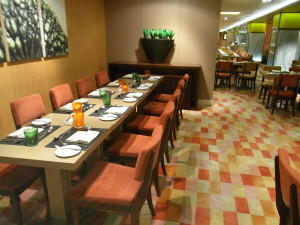
The restaurant biz is quite short-term, restaurants opening up and shutting down every other month. However, there are some measures you can take with your own restaurant to ensure it is here to stay.
Location
Location, location, location! This can either make or break you in the restaurant business. The location would determine your rent, and perhaps even define the price range of your restaurant. It is important to also keep factors in mind such as foot traffic and the type of area – whether residential, professional or commercial – some getting more foot traffic that others. Opening in commercial spaces, such as a mall, would prove lucrative, however rent is oftentimes higher in such establishments.
Marketing
Many restaurants make the mistake of taking their marketing efforts lightly. Restaurants and bars are one of those few businesses that are created solely for people. Hence, identifying your audience and correctly marketing to them would be incredible beneficial. This could go beyond TV advertisements and large hoardings. Even your in-house branding and communication play a role in marketing efforts and can help in promoting your USP.
For example, Doolally’s catchy tagline, ‘Giving Great Head Since 2009,’ sets the tone of the entire brand – it is fun, young, informal and all about beer. Such an approach to communication can help you build a memorable brand and attract the audience you want. Similar considerations should be kept for the décor, ensuring the branding and marketing efforts work well together, rather than appear disconnected.
Online Presence
In the age of the internet, an online presence is an absolute must. The best place to start is a website that captures the essence of your establishment. However, in today’s social media-driven world, a mere website is not enough. A Facebook page, Zomato account and Instagram handle are necessities. Post pictures of your best dishes and offer incentives to customers willing to spread the word. In social media, engagement is everything!
Supplementary steps of actions include creating a Google Maps location to make sure your restaurant is easily discoverable. It is also wise to invest in search engine optimization to have you higher up on Google’s search engine. All these efforts will boost your reach, making more people aware of your restaurant’s existence.
Finally, encourage happy customers to leave reviews online! This can exponentially increase your fan base. Zomato and Tripadvisor accounts help in this regard.
Loyalty-Promotions
Loyalty programs are a great way to not only increase customer engagement, but also incentivize customers to return to your restaurant. There are a variety of simple ways to implement such incentive programs that will in-turn increase your number of loyal customers. A punch card that promises a free item on the purchase of a number of items is a popular incentive. Discounts for birthdays or anniversaries are also widely used, and can make your restaurant a venue for celebration. Probably the most common and versatile program, however, is that of the point system. One can earn points against a certain amount that guests spend and these points can be used to purchase a variety of dishes offered at the restaurant with no extra cost. Who wouldn’t be tempted to return for a free meal?
Inventory Management and Stock Take
The most irritating thing to a customer at your restaurant is to be told that his favorite dish is unavailable. Or that you are out of his favorite soft drink. The best way to avoid such blunders is effective inventory management. Furthermore, it is important to ensure your establishment does not waste food or money by over-ordering perishable items through efficient stock-taking. Smart restaurateurs keep a close watch on their stock levels against the demand of their dishes. A tight control of gross profit margins can make all the difference. Many successful restaurants utilize various inventory management software to keep track of their inventory stock on a daily basis, aiding them in reducing food wastage.
Menu Planning & Organising
A long, diverse menu may seem desirable at first glance, but is confusing to customers and difficult to maintain, resulting in wastage of inventory food items. Cooking different types of dishes needs a lot of prep work and takes a fair bit of time and effort. This may result in sub-par fare and dissatisfied customers. The key is to have a shorter, simpler menu consisting of dishes you can perfect. Using the same ingredients in several dishes helps save inventory and money from being wasted.
Data Analytics
With the power of big data behind us, it would be foolish not to make the most of it, whatever be the business. This is no different for a restaurant. Data analytic softwares have the power to notice patterns and predict them. These include customer preferences, ordering patterns, frequently ordered menu items and the busiest time of the day. Getting a powerful data analytic tool on board your restaurant’s backend is sure to aid the success of your restaurant.
Food Delivery and Quality:
In today’s fast paced world, consumers expect good quality food served in the minimum time frame of 5 minutes to 15 minutes. In many restaurants, stewards utilise various kitchen order apps which help in reducing time take for food delivery by 25 per cent. Restaurants have a better chance at retaining customers by maintaining standards of quality and a minimum time for food delivery.










